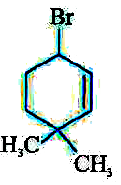1, 1-Dichloroethane reacts with aqueous KOH to give ethanal.
Step-by-Step Solution
1. Identify the Reactants:
- The reactant is 1,1-Dichloroethane, which has the structure CH3-CCl2-CH3.
- The other reactant is aqueous KOH, which provides hydroxide ions (OH⁻).
2. Understand the Reaction Mechanism:
- Aqueous KOH dissociates into K⁺ and OH⁻ ions. The hydroxide ion acts as a nucleophile.
- In 1,1-Dichloroethane, the carbon atoms are bonded to chlorine atoms, making the carbon atoms electrophilic due to the electronegativity of chlorine.
3. Nucleophilic Attack:
- The hydroxide ion (OH⁻) will attack one of the electrophilic carbon atoms, displacing one chlorine atom (Cl⁻) as it is a good leaving group.
- This results in the formation of an intermediate compound: CH3-C(OH)-CH3 with one Cl replaced by OH.
4. Further Reaction:
- The intermediate compound still has one chlorine atom attached. The remaining chlorine can also be replaced by another hydroxide ion.
- The second hydroxide ion attacks the other electrophilic carbon, leading to the formation of a compound with two hydroxyl groups (CH3-C(OH)-OH).
5. Dehydration:
- The compound with two hydroxyl groups is unstable and can undergo dehydration (loss of water).
- During this process, a water molecule (H2O) is eliminated, leading to the formation of a carbonyl compound.
6. Formation of Ethanal:
- The final product after dehydration is Ethanal (acetaldehyde), which has the structure CH3-CHO.
- Thus, the reaction of 1,1-Dichloroethane with aqueous KOH yields Ethanal.
Final Reaction Equation:
1,1-Dichloroethane + 2 KOH (aq) → Ethanal + 2 KCl + H2O
---
- The reactant is 1,1-Dichloroethane, which has the structure CH3-CCl2-CH3.
- The other reactant is aqueous KOH, which provides hydroxide ions (OH⁻).
- Aqueous KOH dissociates into K⁺ and OH⁻ ions. The hydroxide ion acts as a nucleophile.
- In 1,1-Dichloroethane, the carbon atoms are bonded to chlorine atoms, making the carbon atoms electrophilic due to the electronegativity of chlorine.
- The hydroxide ion (OH⁻) will attack one of the electrophilic carbon atoms, displacing one chlorine atom (Cl⁻) as it is a good leaving group.
- This results in the formation of an intermediate compound: CH3-C(OH)-CH3 with one Cl replaced by OH.
- The intermediate compound still has one chlorine atom attached. The remaining chlorine can also be replaced by another hydroxide ion.
- The second hydroxide ion attacks the other electrophilic carbon, leading to the formation of a compound with two hydroxyl groups (CH3-C(OH)-OH).
- The compound with two hydroxyl groups is unstable and can undergo dehydration (loss of water).
- During this process, a water molecule (H2O) is eliminated, leading to the formation of a carbonyl compound.
- The final product after dehydration is Ethanal (acetaldehyde), which has the structure CH3-CHO.
- Thus, the reaction of 1,1-Dichloroethane with aqueous KOH yields Ethanal.
1,1-Dichloroethane + 2 KOH (aq) → Ethanal + 2 KCl + H2O
Topper's Solved these Questions
- HALOALKANES AND HALOARENESBOOK - MODERN PUBLICATIONCHAPTER - HALOALKANES AND HALOARENESEXERCISE - MEMORY TEST (B. Complete the missing links)
11 Videos
- HALOALKANES AND HALOARENESBOOK - MODERN PUBLICATIONCHAPTER - HALOALKANES AND HALOARENESEXERCISE - MEMORY TEST (C. Choose the correct alternative)
12 Videos
- HALOALKANES AND HALOARENESBOOK - MODERN PUBLICATIONCHAPTER - HALOALKANES AND HALOARENESEXERCISE - NCERT examplar Problems (Assertion and Reason Type Questions)
10 Videos
- GENERAL PRINCIPLES AND PROCESSES OF ISOLATION OF ELEMENTSBOOK - MODERN PUBLICATIONCHAPTER - GENERAL PRINCIPLES AND PROCESSES OF ISOLATION OF ELEMENTSEXERCISE - COMPETION FILE (Integer Type Numerical Value Type Questions)
5 Videos
- ORGANIC COMPOUNDS CONTAINING NITROGEN BOOK - MODERN PUBLICATIONCHAPTER - ORGANIC COMPOUNDS CONTAINING NITROGEN EXERCISE - UNIT PRACTICE TEST
5 Videos
Similar Questions
Knowledge Check
 on treatment with aqueous KOHA
on treatment with aqueous KOHA B
B C
C D
D
1-chlorobutane reacts with alcoholic KOH to from
A1-buteneB2-buteneC1-butanolD2-butanolPhenol reacts with aqueous bromine to give :
Ao - bromophenolBm - bromophenolCo & p - bromophenolD2, 4, 6 - tribromophenol.
Assertion (A) : Ethylidene chloride on treatment with aqueous KOH yield ethanal.
Reason (R ) : Ethylene dichloride is a Gemdihalide.
View Solution2,2 -dichlorobutane on boiling with queous KOH gives
View Solution2,2-dichlorobutane on boiling with aqueous KOH gives
View SolutionNBS react with 1-butene to give-
View Solution1,2-Dichloroethane is heated with KOH (1 mol) in ethanol The major product formed is
View Solution
